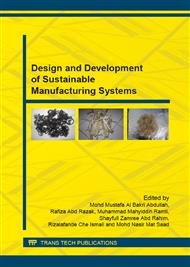[1]
Manz OE. Worldwide production of coal ash and utilization in concrete and others products. Fuel 1997; 76(8): 691-6.
DOI: 10.1016/s0016-2361(96)00215-3
Google Scholar
[2]
Ministerio de Medio Ambiente. Lista europea de residuos. MAM, BOE 19/2/2002, Spain.
Google Scholar
[3]
Kalliopi Anastasiadou, Konstantinos Christopoulos, Epameinontas Mousios, Epameinontas Mousios, Evangelos Gidarakos. Solidification/stabilization of fly and bottom ash from medical waste incineration facility, (2011).
DOI: 10.1016/j.jhazmat.2011.05.027
Google Scholar
[4]
L.G. Carbone, W.H. Gutenmann, D.J. Lisk, Element immobilization in refuse incinerator ashes by solidification in glass, ceramic or cement , Chemosphere 19 (1989) 1951-(1958).
DOI: 10.1016/0045-6535(89)90018-0
Google Scholar
[5]
Hwang, C.L. (2007) Pozolana Concrete Using Manual. Sinotech Engineering Consultants, Inc., Taipei.
Google Scholar
[6]
Biedermann F, Obernberger I. Ash-related problems during biomass combustion and possibilities for a sustainable ash utilization. Proceedings of the international conference world renewable energy congress. Aberdeen, Scotland; (2005).
Google Scholar
[7]
Manz OE. Worldwide production of coal ash and utilization in concrete and others products. Fuel 1997; 76(8): 691-6.
DOI: 10.1016/s0016-2361(96)00215-3
Google Scholar
[8]
NETL National Energy Technology Laboratory. Clean coal technology: Coal utilization by-products. Washington, DC: Department of Energy Office of Fossil Energy; 2006 August. Topical report no. 24.
DOI: 10.2172/6773884
Google Scholar
[9]
A.R. Dincer,Y. Günes¸ , N. Karakaya, Coal-based bottom ash (CBBA) waste material as adsorbent for removal of textile dyestuffs from aqueous solution, J. Hazard. Mater. 141 (2007) 529–535.
DOI: 10.1016/j.jhazmat.2006.07.064
Google Scholar
[10]
V.N. Bashkin, K. Wongyai, Environmental fluxes of arsenic from lignite mining and power generation in northern Thailand, Environ. Geol. 41 (2002) 883–888.
DOI: 10.1007/s002540100404
Google Scholar
[11]
R. Cheerarot, Development of disposed fly ashes and bottom ashes as pozzolanic materials, Master of Engineering thesis, King Mongkut's University of Technology Thonburi, Thailand, (2003).
Google Scholar
[12]
M. Cheriaf, J.C. Rocha, J. Péra, Pozzolanic properties of pulverized coal combustion bottom ash, Cem. Concr. Res. 29 (1999) 1387–1391.
DOI: 10.1016/s0008-8846(99)00098-8
Google Scholar
[13]
H. Kurama and M. Kaya, Usage of coal combustion bottom ash in concrete mixture, Constr. Build. Mater., vol. 22, no. 9, p.1922–1928, (2008).
DOI: 10.1016/j.conbuildmat.2007.07.008
Google Scholar
[14]
P. Tang, M.V.A. Florea, P. Spiesz, H.J.H. Brouwers. The application of treated bottom ash in mortar as cement replacement, (2014).
Google Scholar
[15]
L.B. Andrade, J.C. Rocha, M. Cheriaf. Influence of coal bottom ash as fine aggregate on fresh properties of concrete, (2008).
DOI: 10.1016/j.conbuildmat.2008.05.003
Google Scholar
[16]
A. Sathonsaowaphak, P. Chindaprasirt, and K. Pimraksa, Workability and strength of lignite bottom ash geopolymer mortar, J. Hazard. Mater., vol. 168, no. 1, p.44–50, (2009).
DOI: 10.1016/j.jhazmat.2009.01.120
Google Scholar
[17]
B.R. Hart, M.A. Powell W.S. Fyfe, Geochemistry and mineralogy of fly-ash from the MaeMoh lignite deposit, Thailand, Energy Sources 17 (1995) 23–40.
DOI: 10.1080/00908319508946069
Google Scholar
[18]
I. Demir, R.E. Hughes, P.J. DeMaris, Formation and use of coal combustion residues fromthree types of power plants burning Illinois coals, Fuel 80 (2001) 1659–1673.
DOI: 10.1016/s0016-2361(01)00028-x
Google Scholar
[19]
M.J. Shannag, A. Yeginobali, Properties of pastes, mortars and concretes con- taining natural pozzolan, Cem. Concr. Res. 25 (1995) 647–657.
DOI: 10.1016/0008-8846(95)00053-f
Google Scholar
[20]
S. Bethanis, C.R. Cheeseman, C.J. Sollars. Properties and microstructure of sintered incinerator bottom ash, (2002).
DOI: 10.1016/s0272-8842(02)00068-8
Google Scholar
[21]
C.R. Cheeseman, S. Monteiro da Rocha, C. Sollars, S. Bethanis, A.R. Boccaccini. Ceramic processing of incinerator bottom ash, (2003).
DOI: 10.1016/s0956-053x(03)00039-4
Google Scholar
[22]
Dugenest, S., Casabianca, H., Grenier_Loustalot, M., 1999. Municipal solid waste incineration bottom ash: physicochemical characterization of organic matter. Analusis 27, 75-81.
DOI: 10.1051/analusis:1999110
Google Scholar
[23]
J.E. Aubert, B. Husson, N. Sarramone, Utilization of municipal solid waste incineration (MSWI) fly ash in blended cement: Part 1: processing and characterization of MSWI fly ash , J. Hazard. Mater. 136 (2006) 624–631.
DOI: 10.1016/j.jhazmat.2005.12.041
Google Scholar
[24]
H.S. Shi, L.L. Kan, Leaching behavior of heavy metals from municipal solid wastes incineration (MSWI) fly ash used in concrete, J. Hazard. Mater. 164 (2009) 750–754.
DOI: 10.1016/j.jhazmat.2008.08.077
Google Scholar
[25]
F.Y. Chang, M.Y. Wey, Comparison of the characteristics of bottom and fly ashes generated from various incineration processes, J. Hazard. Mater. 138 (2006) 594–603.
DOI: 10.1016/j.jhazmat.2006.05.099
Google Scholar
[26]
Y. Aggarwal and R. Siddique, Microstructure and properties of concrete using bottom ash and waste foundry sand as partial replacement of fine aggregates, Constr. Build. Mater., vol. 54, p.210–223, (2014).
DOI: 10.1016/j.conbuildmat.2013.12.051
Google Scholar
[27]
M. Whittaker, R. Taylor, Q. Li, S. Li, and L. B. Project, The Effects of Bottom Ash as a Partial Cement Replacement The Effects of Bottom Ash as a Partial Cement Replacement, 2009.
Google Scholar


